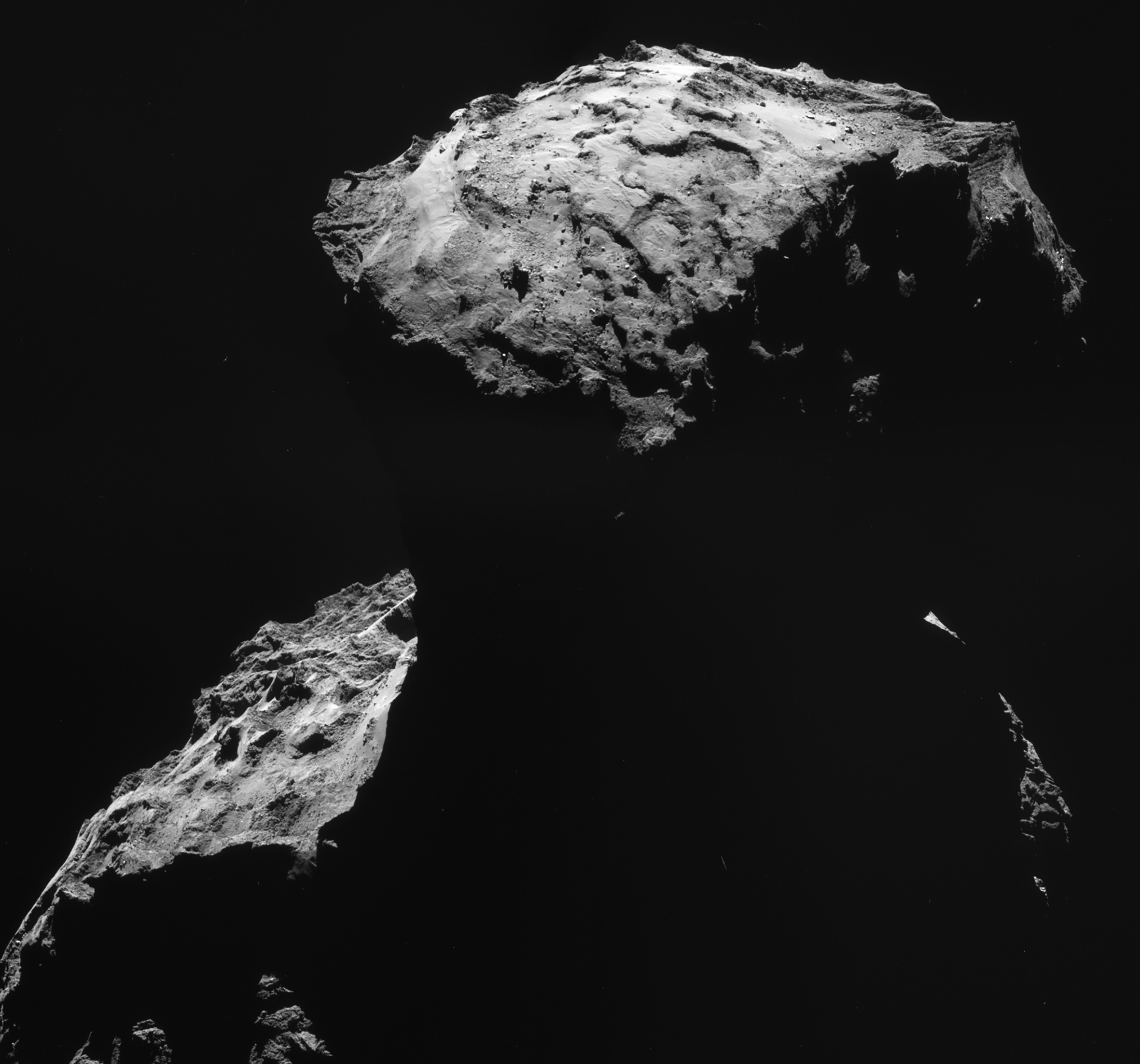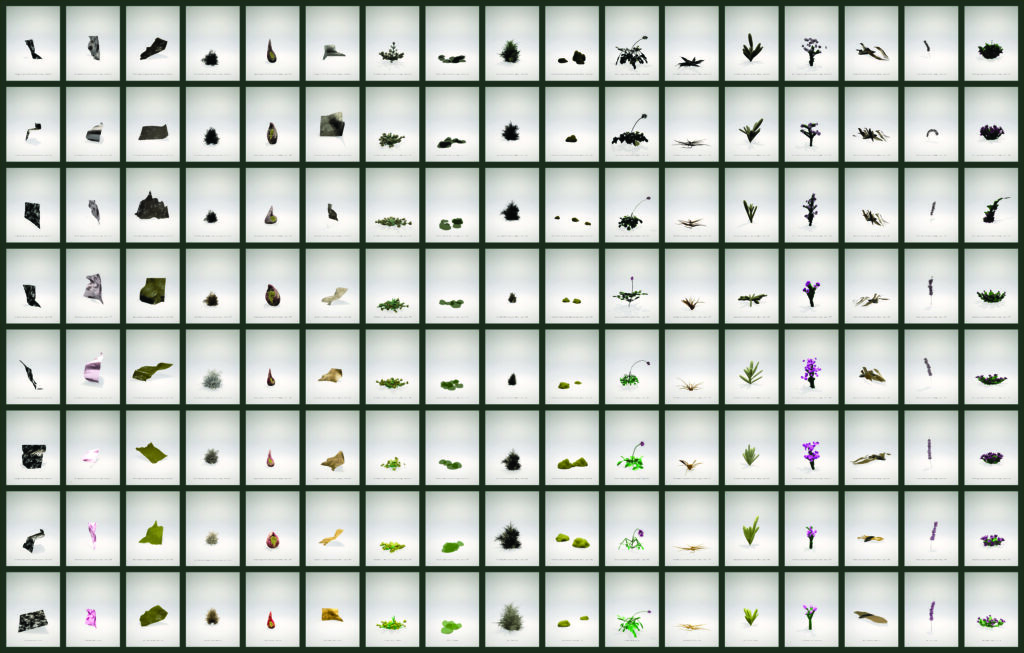Comet Composition/Alien Materiality: Resilience, Attunement and our Sonic Imagination

The European Space Agency’s Rosetta mission, launched in March 2004, made an intriguing discovery in August 2014 on its approach to a comet orbiting Jupiter known as 67P/Churyumov-Gerasimenko (67P/C-G, for short). Focused on efforts to soft land a robotic landing module named Philae on the comet, the Rosetta space probe’s magnetometer picked up a low-frequency range of electromagnetic waves inaudible to the human ear. After increasing the frequencies 10,000 times to allow for human reception, the resultant sound composition picked up by the spacecraft’s instruments could easily be imagined as the vocalisation of some new sentient life form wending its way through the oceanic vacuum of outer space. While these sounds are theorised to be the result of oscillations in the magnetic field around the comet as it interacts with the solar wind, the imaginative potential provided by this discovery offers one unique way to think about how knowledge is produced irrespective of human intervention. This celestial body and its song point to the importance of sound for analysis of phenomena external to human-based experience. In disclosing the possibility of compositional sound originating outside human experience, this sonic discovery points to a whole new set of questions and understandings about how the world and universe work and interrelate. Whether we think of these electromagnetic frequencies as a random set of oscillations dispersing into the vast emptiness of outer space, or whether we interpret them as patterns of communication occurring outside of human spatial and perceptual awareness, they provide a fascinating set of possibilities toward understanding both the limitations of human sound perception, and the limitlessness of nonhuman and object-based sound production.
Sound has played a unique role within space exploration through its use in representing an idea of humankind and life on Earth for an unknown, but imagined, interstellar audience. Now in its 44th year, NASA’s Voyager mission launched twin spacecraft in August and September 1977 for purposes of detailed flyby studies of Jupiter and Saturn and their two largest moons, Io and Titan. After successfully extending the mission of Voyager 2 to include pioneering studies of Neptune and Uranus, both spacecraft officially embarked in 1990 on their current mission of exploring interstellar space beyond our own solar system. That both Voyager spacecraft carry a golden phonograph containing images, music and sounds showcasing the diversity of life on Earth provides an interesting counterpoint to the low-frequency sonic output of comet 67P/C-G.
Accompanying the assortment of genre-based and traditional music from around the globe, these golden records also include acoustic ecological sounds produced by the Earth’s complex interwoven system of spheres ‒ the biosphere, hydrosphere, lithosphere, atmosphere, and cryosphere. Alongside bird and whale song, cricket chirps and frog calls, and the sounds of thunderstorms, earthquakes, wind and rain, we also hear the sounds of the Anthropocene. These sounds range from human biological to human cultural sounds, revealing for an extraterrestrial listener what the golden records’ curator Carl Sagan and his team of collaborators believed to be uniquely human sounds: the beat of the human heart, laughter, the sounds of mother and child, the diversity of the globe’s languages captured in 55 greetings to the universe, and the ingenuity of human invention and human advancement with the sounds of early tools: Morse Code, a horse and cart, automobile, train, and aircraft. This sound archive of human life and civilisation on Earth is very much an imaginative product of human agency, an idea that denotes the capacity of human beings to act within any given environment or network of relationships, and one that commonly takes humans’ relationships with nonhuman counterparts (e.g., animals and plants) for granted. In the arrangement of sounds chosen for inclusion on the Voyager golden record we can clearly see the importance placed on how these sounds contextualize and support human agency as the central player in the development of knowledge. Rather than being understood as providing other models of experience, the sounds of the Earth’s interwoven system of spheres serve as ambient background material for humankind’s continued pursuit of that knowledge.
While these human-produced sounds are far from the only types of sound that exist in the Anthropocene, they do tend to drown out the numerous other sounds produced by the remaining animals, plants, and non-human lifeforms that also inhabit Earth’s complex network of interconnected spheres. The examples of the Voyager records and the low-frequency song of the comet can help us to understand the importance of sound for these complex networks by highlighting these notions of human and nonhuman agency. Their relationship hinges on whether or not humans engage these networks from a position of authority, control and regulation or from a position of attunement arising from a shared understanding of a moral and ethical responsibility for the mutual benefit of all of the Earth’s inhabitants. At the core of such complex systems’ sets of adaptive capacities is the multifaceted process of resilience, which carries along with it an equally ephemeral notion of risk and its potential either to support or threaten flexibility within such systems. Resilience represents the capacity of an ecosystem to absorb and/or recover from a disturbance (natural storms, wildlife depletion, human population growth, economic development, etc.) without causing a threshold shift into a different stable state of existence. This notion of stability indicates the system may have weathered the disturbance, but it has also lost one or more beneficial agents from the prior state, to which it is difficult to return¹. In their volume Resilience Thinking Brian Walker and David Salt point to the practices of optimisation and efficiency within ecosystem management for our inability to create and maintain sustainable systems without ‘drastic losses in resilience.’ In their discussion of optimisation Walker and Salt reference an approach that:
aims to get a system into some particular ‘optimal state,’ and then hold it there. That state, it is believed, will deliver maximum sustained benefit. It is sometimes recognized that the optimal state may vary under different conditions, and the approach is then to find the optimal path for the state of the system. This approach is sometimes referred to as a maximum sustainable yield or optimal sustainable yield paradigm².
These models rely on a formula of natural resource and wildlife management to ensure that a maximum level of harvest (timber, fish catch, etc.) is attained without leading to depletion of the resources in question. But what these models do not account for are those elements of intrinsic and unquantifiable value that Walker and Salt term ecosystem services’ – ‘the life support, regenerative, and cleansing services that nature provides,’ as well as ‘the values placed on beauty or on the existence of species for their own sakes.³’ The presence or absence of sound forms an integral component of these ecosystem services, and serves as a marker for discovering nonhuman agents and the sonic and other knowledges they produce. When taken in the context of our Anthropocene ‘moment’ these concurrent processes of resilience and risk so crucial for adaptability often become more about optimising toward an idea of an ideal or peak resilience and minimising the importance of risk and precariousness so that humans may continue to thrive within the rapidly less sustainable ecosystem. Without the risk and the potential for disturbance and without an acknowledgment of the importance that complexity plays within and across such systems, then sustainability becomes less about the transformative capacity of the system, and more about a rigidity of optimal outcomes that overlooks the flexibility of the system’s numerous actors.
In veering away from the value of complexity needed for adaptability, we lose sight of and sound of other models of experience that should enhance and accompany our perception of our own model of experience. The song produced by comet 67P/C-G throws into stark relief the importance for thinking otherwise about the significance we place on human thought, human experience, and human action in articulating the hyper-objective scale and deep time of our many complex sustainability issues (e.g. climate change, biodiversity and species extinction, water scarcity and food security) and for engaging responses to these issues in some way. The alien materiality of the comet’s composition, the long trajectory it participates in across space and time, and the low frequency waves it produces across that traverse all call attention to the limits of our knowledge, and the limits of our experience. When expanded beyond the specifics of comet 67P/C-G, the sonic realm allows us to rethink the very limits of human resilience alongside the nonhuman. The delicate set of entanglements we share with plants, animals, geologies and atmospheres, and with other humans, necessitates that we also continually open our sonic imaginations to those entanglements within and beyond the human.
Sound in all of its forms, whether as hearing and listening, as musicality, as echo and reverb, as language and voice, as communication, or as representation, has always been a crucial component in humankind’s effort to know. As both a medium and a perceptual modality, sound carries within it a whole range of possible knowledges. Spatial, ideational, affective, temporal, experiential, scientific, acoustic, and/or speculative threads may reside within any sound wave to be heard by the multiple possible recipients of that sound wave with the right biology or technology available for hearing it. Sound is thus always compositional in its production and its reception, drawing discrete but momentary connections between its points of origination and its points of arrival, whereupon it once again triggers a compositional move dependent on the cognitive, instinctual, biosemiotic, and physical abilities and needs of its varying recipients. Seen in this way, the comet and its song are also important for their ability to unsettle long-held understandings about how the world and the universe work as a product of the human compulsion for creating information, producing knowledge, and building archives meant to contain and valorise them. Their sound-based alignments provoke numerous phenomenological questions ranging from humankind’s unique position within the universe, to the changing nature and value of non-human, non-sentient, and non-biological agency for engaging complex environmental and existential problems, and, for that matter, to a critical reframing of the Anthropocene concept beyond the definitional and metaphoric roles it has come to encompass.
The Rosetta mission lasted a period of 150 months and 27 days, from its launch on 3 March 2004 to the official mission completion on 30 September 2016 with a controlled descent to the comet surface and the loss of its signal upon impact. In contrast, comet 67P/C-G originates from the Kuiper belt, an extremely cold region of the outer solar system containing bodies believed to be primitive remnants from the early phases of the solar system⁴. In the relatively short human rendezvous with 67P/C-G the ingredients of risk and precariousness are central to the encounter but become disguised as routine elements to narrate the power of human technical ingenuity vis-à-vis the unpredictability of the comet’s lithic imagination⁵. Risk perception also exists in this realm of the imaginary, as a visualisation of potential threats and benefits to any one system’s sustainability, while precariousness arises within the momentariness of the encounter, setting the perception of risk into performative action alongside the non scriptable uncertainties bound up by the comet’s very existence. Without a human technical solution, the inaudibility of the low-frequency electromagnetic waves produced by the comet’s orbit through space would have inscribed the encounter as one involving the impossibility of sound, as belonging to a realm where sound doesn’t or shouldn’t occur. Yet even with the technical solution and the discovery that sound is possible, our human capacity to attach meaning to the event still resides within that imaginary. Perhaps this helps form a truer definition of resilience, wherein risk and precariousness act as imagined and immeasurable performance variables given the spatiotemporal uniqueness of the encounter. And perhaps the value of the precarious moment provides us with some response or counter to the selfish conceit and accompanying hedonism that an Anthropocene thinking foregrounds by making us confront the very limitations of how we produce a knowledge that doesn’t include, in some way, the value of the imaginary, and the value of our sonic imaginations.

Cover of the Voyager Golden Record
This gold aluminium cover was designed to protect the Voyager 1 and 2 ‘Sounds of Earth’ gold-plated records from micrometeorite bombardment, but also serves a double purpose in providing the finder a key to playing the record. The explanatory diagram appears on both the inner and outer surfaces of the cover, as the outer diagram will be eroded in time. Flying aboard Voyagers 1 and 2 are identical ‘golden’ records, carrying the story of Earth far into deep space. The 12 inch gold-plated copper discs contain greetings in 60 languages, samples of music from different cultures and eras, and natural and man-made sounds from Earth. They also contain electronic information that an advanced technological civilisation could convert into diagrams and photographs. Currently, both Voyager probes are sailing adrift in the black sea of interplanetary space, flying towards the outmost border of our solar system.
Copyright: NASA 1977
Daniel Gilfillan is Associate Professor of German Studies and a Senior Global Futures Scholar in the Julie Ann Wrigley Global Futures Laboratory at Arizona State University. He is the author of Pieces of Sound: German Experimental Radio (Minnesota, 2009), and has published widely on German/Austrian radio- and sound art. He is currently working on a book project titled The Unsung Planet: Resilience, Resonance and Our Sonic Imagination.
- Brian Walker and David Salt, Resilience Thinking: Sustaining Ecosystems and People in a Changing World, Washington, DC Island Press, 2006, pp. 36-38.
- ibid, pp. 6-7.
- ibid, p. 7
- For an interesting multimedia timeline animation plotting the orbital arc of the Rosetta spacecraft and detailing milestones from the mission, see ‘Where is the Rosetta?’, ESA Science & Technology, https://sci.esa.int/where_is_rosetta






